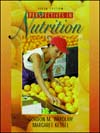 |  Perspectives in Nutrition, 5/e Gordon M. Wardlaw,
Ohio State University
Margaret W. Kessel,
Ohio State University
The Water-Soluble Vitamins
Chapter 10 Summary- Thiamin in its functional form as TPP serves as a coenzyme in decarboxylation
and transketolase reactions of carbohydrates. It is involved in neurotransmission
and nerve conduction. About the only North American population that could be
deficient in thiamin are alcoholics. Pork, pork products, and enriched grains
are reliable sources of thiamin.
- Riboflavin in functional form, FAD and FMN, participates in a wide variety
of oxidation-reduction reactions in numerous metabolic pathways that produce
energy. A pure riboflavin deficiency is unlikely but could accompany other B-vitamin
deficiencies. Dairy products and enriched grains are good dietary sources.
- Niacin as NAD and NADP are coenzymes. NAD is important in oxidation-reduction
reactions that yield energy. A deficiency of the vitamin produces the disease
pellagra. Alcoholism can lead to a deficiency. Food sources of niacin are enriched
cereal grains and protein foods. The body is able to synthesize the vitamin
from the amino acid tryptophan. Megadoses of niacin produce a variety of toxic
symptoms.
- Pantothenic acid in coenzyme form (CoA) shuttles two carbon fragments from
the metabolism of glucose, amino acids, fatty acids, and alcohol into the citric
acid cycle during energy metabolism. A deficiency of pantothenic acid is unlikely,
since it is widely distributed in foods.
- Biotin functions as a cofactor in four carboxylases, enzymes that add carbon
dioxide to a substance. Biotin is widely distributed in foods. No deficiency
exists in healthy people. Intestinal bacteria also synthesize biotin.
- Vitamin B-6 in coenzyme form (PLP) participates in amino acid metabolism,
especially the synthesis of nonessential amino acids. It is essential in the
synthesis of heme in hemoglobin and the formation of certain neurotransmitters.
Anemia, convulsions, and decreased immune response are symptoms of a deficiency.
Animal protein foods, vegetables, and whole-grain cereals are good sources of
this vitamin. It is not effective in treating PMS or carpal tunnel syndrome.
Toxic effects include nerve damage.
- Folate in one of its many coenzyme forms (tetrahydrofolic acid) accepts one-carbon
groups from various donors and serves up one-carbon groups to a variety of metabolic
pathways. The most notable job performed by folate is DNA synthesis. A dietary
lack of the vitamin produces megaloblastic anemia and spina bifida and is one
cause of heart disease (through the homocysteine link). Deficiency is common
among alcoholics. Folate is found in green vegetables, legumes, liver, and fortified
cereal grains. Folate is destroyed by high cooking temperatures.
- Vitamin B-12 in two coenzyme forms allows three-carbon fatty acids to be oxidized
for energy and promotes normal red blood cell formation. Because of its interaction
with folate, a deficiency of vitamin B-12 results in the same type of megaloblastic
anemia, as well as excess homocysteine in the blood. Defective absorption of
vitamin B-12 is the cause of the deficiency disease pernicious anemia, which
frequently occurs in older adults. In such cases, megadose supplements or injection
of the vitamin is necessary. Vitamin B-12 occurs in animal foods but not in
plant foods. Vegans need to look for foods fortified with the vitamin or take
a supplement. Normally, the liver has a 5-year supply of vitamin B-12 in storage.
- Choline is a dietary component that is available from a wide variety of foods
and is synthesized in the body. No natural deficiency of choline has been reported.
The amino acid methionine, vitamin B-6, vitamin B-12, and folate, along with
choline, are intricately involved in the metabolism of the amino acid homocysteine.
Elevated homocysteine in the blood is considered a risk factor for atherosclerosis.
- Vitamin C does not function as a coenzyme, like the B-vitamins. One of its
many roles is in the synthesis of collagen, the protein used to form connective
tissue. A deficiency of vitamin C causes the disease scurvy. Fresh fruits and
vegetable are reliable sources of this vitamin. Like folate, vitamin C is destroyed
by heat. Among North Americans, alcoholics and older men who don't eat fresh
produce are most likely to develop a deficiency. Megadoses of the vitamin causes
gastrointestinal upsets but little else.
- Carnitine, inositol, taurine, and lipoic acid, while participating in many
important biochemical reactions in the body, are not true vitamins because they
can be synthesized in the body from readily available precursors, or obtained
from the diet.
|
|



 2002 McGraw-Hill Higher Education
2002 McGraw-Hill Higher Education